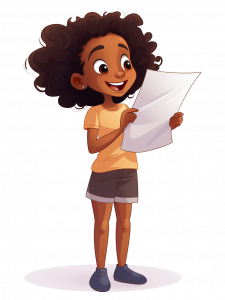What Is Lyric Poetry?
You’ve probably heard the word “lyric” before, meaning the words of a song. Today we’re going to be talking about another meaning of the same word. We’re going to talk about lyric poetry.
Because “lyric poetry” and “song lyrics” sound similar, it’s easy to mix them up, but they’re really two different things. Lyrics in a song are just the words that go with the music, whether they describe the singer’s feelings or not. But a “lyric poem” is a special kind of poetry where you express your feelings and thoughts, no music needed.
While some kinds of poems tell stories, or describe things, In a lyric poem, you share your emotions, moods, and feelings. Whether you’re super excited, kind of sad, maybe a bit angry, or even if you’re just marveling at the beauty of a sunset, lyric poems capture these moments and put them into words.
Because lyric poems express the poet’s emotions, they are usually written from the poet’s point, using words like “I” and “my” rather than talking about something or someone else. In other words, you might say, “I am feeling happy” rather than “Hannah’s feeling happy.” Got it?

And, lastly, lyric poems are usually short and often rhyme because, in ancient times, they were meant to be sung and accompanied by a musical instrument, such as a lyre, a small instrument like a tiny harp. In fact, the word lyric comes from “lyre.” Pretty cool, right?
What About “Dramatic” Poetry?

Some lyric poems are also “dramatic poems.” A dramatic poem is a lyric poem that describes emotions about a situation in a way that’s very expressive, almost like you’re acting on a stage. They’re not just about your feelings; they’re meant to be read aloud, maybe even acted out before an audience.
In other words, all dramatic poems are lyric poems, but not all lyric poems are dramatic poems. Make sense?
A Few Fun Examples
In each of these lyric poems, the poet is expressing their emotions about something:
- In the shape poem “Pizza, Pizza, I Love You” the poet shares their feelings of love with their favorite food.
- In the poem “Zoom Gloom” the poet complains about how bored they are with remote learning.
- And in “Whenever It’s December” the poet describes the joy of remembering the year past and looking forward to the new one.
Now, let’s get you writing your own lyric poem! Here are several ways to start…
Choose a Feeling
Think of a feeling you want to write about. It could be happiness, sadness, excitement, or even wonder. Write it down, and maybe add a detail or two, like this:
I’m angry! I’m angry! I just want to scream!
or
I’ve never been as happy as the way I’m feeling now.
Then continue your poem, telling the world what it is that you are angry or happy or excited about.
Pick a Moment
Or pick a moment that was filled with emotion, like the first time you played in the snow, or a particularly disgusting food you had to eat, and get started. But rather than describe it in the past, place yourself in the moment, as if it’s happening to you now. Maybe your poem begins like this:
I can’t believe I didn’t know,
I love, I love, I love the snow!
or maybe this:
This Brussels sprout that’s on my plate
is something that I truly hate.
Write About Something You Like or Don’t Like
If you can’t think of a moment or a feeling, maybe just think of something you like or don’t like. Love your Xbox? Write about that. Can’t wait for the end of the school year? Tell the world about it! Wish that your cat would stop attacking you? There’s even a lyric poem in that.
One of my favorite lyric poem that describes something the poet doesn’t like is “Homework! Oh, Homework!” by Jack Prelutsky, which begins like this:
Homework! Oh, Homework!
I hate you! You stink!
I wish I could wash you away in the sink,
if only a bomb
would explode you to bits.
Homework! Oh, homework!
You’re giving me fits.
Useful Tips for Writing Lyric Poetry
Now that you know how to get started writing a lyric poem, here are a few more tips to help you as you write:
Use Descriptive Words: To make your poem vivid, use descriptive words. For example, if you’re writing about you feel when you visit the beach, you can talk about the ‘sparkling blue waves’ or the ‘soaring white seagulls.’ These descriptions help your readers picture and feel what you’re saying.
Create Short Lines: Lyric poems usually have short lines and often rhyme, though they don’t have to. Instead of writing long sentences or paragraphs, try writing short lines with just a few words, and maybe rhyming just a bit. Look at the examples above to see what I mean.
Read Lyric Poems Written by Other Poets: The more lyric poems you read that were written by others, the more ideas and inspiration you will get. Reading lots of poems will show you many different ways to go about expressing your own emotions in poetry. (Just remember not to copy other poets’ words, but to use your own instead.)
Share Your Feelings: Don’t be shy about putting your feelings into words. After all, that is the whole point of lyric poems. If a walk in the woods made you feel peaceful, write about that peaceful feeling. If it excited you, let that excitement show in your words.
Read it Aloud: Once you’ve written your poem, read it out loud. Lyric poetry is about expressing emotion, and hearing the words can help you feel if the emotion is coming through.
And remember…
There’s No Right or Wrong: In poetry, your feelings and how you express them are always right.
Practice Makes Perfect: The more you write, the better you’ll get at expressing yourself.
Have Fun: Writing poetry is like painting with words. So enjoy the process of creating something new and expressive!
- Update to Poems-by-Length Page - April 18, 2024
- Create Your Own Poetic Puppet Show - April 16, 2024
- Leap into Laughter with “A Festival for Frogs” - March 26, 2024






